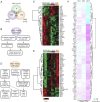Genomically amplified Akt3 activates DNA repair pathway and promotes glioma progression
- PMID: 25737557
- PMCID: PMC4371922
- DOI: 10.1073/pnas.1414573112
Genomically amplified Akt3 activates DNA repair pathway and promotes glioma progression
Abstract
Akt is a robust oncogene that plays key roles in the development and progression of many cancers, including glioma. We evaluated the differential propensities of the Akt isoforms toward progression in the well-characterized RCAS/Ntv-a mouse model of PDGFB-driven low grade glioma. A constitutively active myristoylated form of Akt1 did not induce high-grade glioma (HGG). In stark contrast, Akt2 and Akt3 showed strong progression potential with 78% and 97% of tumors diagnosed as HGG, respectively. We further revealed that significant variations in polarity and hydropathy values among the Akt isoforms in both the pleckstrin homology domain (P domain) and regulatory domain (R domain) were critical in mediating glioma progression. Gene expression profiles from representative Akt-derived tumors indicated dominant and distinct roles for Akt3, consisting primarily of DNA repair pathways. TCGA data from human GBM closely reflected the DNA repair function, as Akt3 was significantly correlated with a 76-gene signature DNA repair panel. Consistently, compared with Akt1 and Akt2 overexpression models, Akt3-expressing human GBM cells had enhanced activation of DNA repair proteins, leading to increased DNA repair and subsequent resistance to radiation and temozolomide. Given the wide range of Akt3-amplified cancers, Akt3 may represent a key resistance factor.
Keywords: Akt; DNA repair; RCAS/tv-a mouse model; glioma.
Conflict of interest statement
The authors declare no conflict of interest.
Figures




Comment in
-
OverAKT3: tumor progression and chemoresistance.Cell Cycle. 2015;14(13):1993-4. doi: 10.1080/15384101.2015.1046787. Epub 2015 Apr 30. Cell Cycle. 2015. PMID: 25927491 Free PMC article. No abstract available.
Similar articles
-
The role of AKT isoforms in glioblastoma: AKT3 delays tumor progression.J Neurooncol. 2016 Oct;130(1):43-52. doi: 10.1007/s11060-016-2220-z. Epub 2016 Jul 15. J Neurooncol. 2016. PMID: 27422127 Free PMC article.
-
Akt2 and Akt3 play a pivotal role in malignant gliomas.Neuro Oncol. 2010 Mar;12(3):221-32. doi: 10.1093/neuonc/nop026. Epub 2009 Dec 21. Neuro Oncol. 2010. PMID: 20167810 Free PMC article.
-
MicroRNA-203 Modulates the Radiation Sensitivity of Human Malignant Glioma Cells.Int J Radiat Oncol Biol Phys. 2016 Feb 1;94(2):412-20. doi: 10.1016/j.ijrobp.2015.10.001. Epub 2015 Oct 9. Int J Radiat Oncol Biol Phys. 2016. PMID: 26678661
-
Role of Akt in human malignant glioma: from oncogenesis to tumor aggressiveness.J Neurooncol. 2014 Apr;117(2):205-15. doi: 10.1007/s11060-014-1382-9. Epub 2014 Jan 30. J Neurooncol. 2014. PMID: 24477623 Review.
-
Phosphatidylinositol 3-kinase/Akt signaling as a key mediator of tumor cell responsiveness to radiation.Semin Cancer Biol. 2015 Dec;35:180-90. doi: 10.1016/j.semcancer.2015.07.003. Epub 2015 Jul 17. Semin Cancer Biol. 2015. PMID: 26192967 Review.
Cited by
-
OverAKT3: tumor progression and chemoresistance.Cell Cycle. 2015;14(13):1993-4. doi: 10.1080/15384101.2015.1046787. Epub 2015 Apr 30. Cell Cycle. 2015. PMID: 25927491 Free PMC article. No abstract available.
-
Identify a DNA Damage Repair Gene Signature for Predicting Prognosis and Immunotherapy Response in Cervical Squamous Cell Carcinoma.J Oncol. 2022 Mar 23;2022:8736575. doi: 10.1155/2022/8736575. eCollection 2022. J Oncol. 2022. PMID: 35368888 Free PMC article.
-
Cancer Subclones Derived from the Patient's Head and Neck Squamous Cell Carcinoma Tumor Stem Cells for the Screening of Personalized Antitumor Immunotherapy and Chemotherapy.Stem Cell Res Ther (Walnut). 2018;3(1):116-121. Epub 2018 Nov 29. Stem Cell Res Ther (Walnut). 2018. PMID: 30972376 Free PMC article.
-
MicroRNA-497 impairs the growth of chemoresistant neuroblastoma cells by targeting cell cycle, survival and vascular permeability genes.Oncotarget. 2016 Feb 23;7(8):9271-87. doi: 10.18632/oncotarget.7005. Oncotarget. 2016. PMID: 26824183 Free PMC article.
-
Circular RNA ZNF609 functions as a competitive endogenous RNA to regulate AKT3 expression by sponging miR-150-5p in Hirschsprung's disease.Oncotarget. 2017 Jan 3;8(1):808-818. doi: 10.18632/oncotarget.13656. Oncotarget. 2017. PMID: 27903978 Free PMC article.
References
-
- Altomare DA, Testa JR. Perturbations of the AKT signaling pathway in human cancer. Oncogene. 2005;24(50):7455–7464. - PubMed
Publication types
MeSH terms
Substances
Associated data
- Actions
Grants and funding
LinkOut - more resources
Full Text Sources
Other Literature Sources
Medical
Molecular Biology Databases
Miscellaneous

